Related Research Articles

Giza is the third-largest city in Egypt by area after Cairo and Alexandria; and fourth-largest city in Africa by population after Kinshasa, Lagos, and Cairo. It is the capital of Giza Governorate with a total population of 4,872,448 in the 2017 census. It is located on the west bank of the Nile opposite central Cairo, and is a part of the Greater Cairo metropolis. Giza lies less than 30 km (18.64 mi) north of Memphis, which was the capital city of the unified Egyptian state during the reign of pharaoh Narmer, roughly 3100 BC.
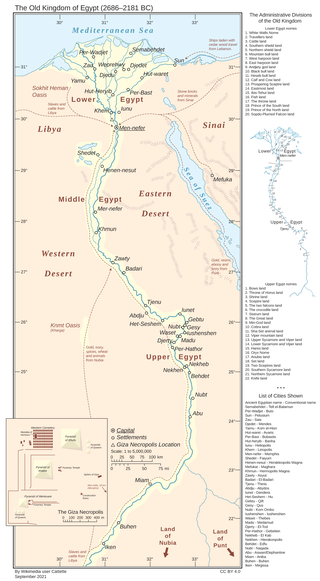
In ancient Egyptian history, the Old Kingdom is the period spanning c. 2700–2200 BC. It is also known as the "Age of the Pyramids" or the "Age of the Pyramid Builders", as it encompasses the reigns of the great pyramid-builders of the Fourth Dynasty, such as King Sneferu, who perfected the art of pyramid-building, and the kings Khufu, Khafre and Menkaure, who constructed the pyramids at Giza. Egypt attained its first sustained peak of civilization during the Old Kingdom, the first of three so-called "Kingdom" periods, which mark the high points of civilization in the lower Nile Valley.

Khafre or Khafra, also known as Khephren or Chephren, was an ancient Egyptian pharaoh of the Fourth Dynasty during the Old Kingdom. He was the son of Khufu and the successor of Djedefre.

Dahshur is an ancient Egyptian pyramid complex and necropolis and shares the name of the nearby village of Manshiyyat Dahshur in markaz Badrashin, Giza.
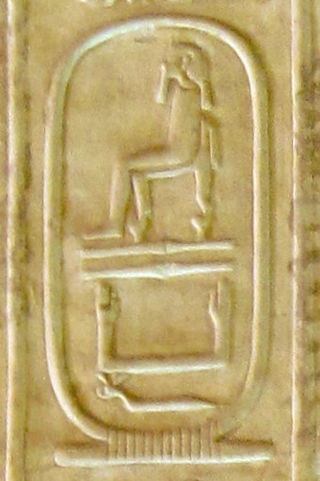
Shepseskaf was a pharaoh of ancient Egypt, the sixth and probably last ruler of the fourth dynasty during the Old Kingdom period. He reigned most probably for four but possibly up to seven years in the late 26th to mid-25th century BC.

The pyramid of Menkaure is the smallest of the three main pyramids of the Giza pyramid complex, located on the Giza Plateau in the southwestern outskirts of Cairo, Egypt. It is thought to have been built to serve as the tomb of the Fourth Dynasty Egyptian Pharaoh Menkaure.

The Giza pyramid complex in Egypt is home to the Great Pyramid, the Pyramid of Khafre, and the Pyramid of Menkaure, along with their associated pyramid complexes and the Great Sphinx. All were built during the Fourth Dynasty of the Old Kingdom of ancient Egypt, between c. 2600 – c. 2500 BC. The site also includes several temples, cemeteries, and the remains of a workers' village.

Mark Lehner is an American archaeologist with more than 30 years of experience excavating in Egypt. He is the director of Ancient Egypt Research Associates (AERA) and has appeared in numerous tv documentaries.
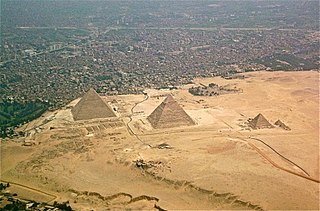
The Giza Plateau is a limestone plateau in Giza, Egypt, the site of the Fourth Dynasty Giza pyramid complex, which includes the pyramids of Khufu, Khafre and Menkaure, the Great Sphinx, several cemeteries, a workers' village and an industrial complex. It forms the northernmost part of the 16,000 ha Pyramid Fields in the Western Desert edge of the Nile Valley that are part of the UNESCO World Heritage Site, Memphis and its Necropolis.

The pyramid of Neferirkare was built for the Fifth Dynasty pharaoh Neferirkare Kakai in the 25th century BC. It was the tallest structure on the highest site at the necropolis of Abusir, found between Giza and Saqqara, and still towers over the necropolis. The pyramid is also significant because its excavation led to the discovery of the Abusir Papyri.

A necropolis is a large, designed cemetery with elaborate tomb monuments. The name stems from the Ancient Greek νεκρόπολις nekropolis.
Meritites I was an ancient Egyptian queen of the 4th Dynasty. Her name means "Beloved of her Father". Several of her titles are known from a stela found at Giza. She was buried in the middle Queen’s Pyramid in Giza.
The Memphite Necropolis is a series of ancient Egyptian funerary complexes occupying a 30-kilometer (19 mi) stretch on the Western Desert plateau in the vicinity of the ancient capital of Memphis, Lower Egypt, today in Giza, Egypt. It includes the pyramid complexes of Giza, Abusir, Saqqara and Dahshur, and is listed as the UNESCO World Heritage Site of Memphis and its Necropolis. Most of the pyramids of the Old Kingdom were built here, along with many mastabas and other tombs.

G1-a is one of the subsidiary pyramids of the Giza East Field of the Giza Necropolis, located immediately to the eastern side of the Great Pyramid of Giza. It was built during the Fourth Dynasty of Egypt. The tomb is the northernmost of the three pyramids of the queens.
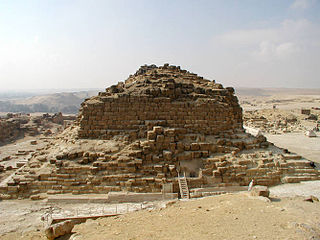
G1-b is one of the subsidiary pyramids of the Giza East Field of the Giza Necropolis immediately to the eastern side of the Great Pyramid of Giza, built during the Fourth Dynasty of Egypt. It is the central of the three pyramids of the queens, located ten meters south of the Pyramid G1-a. It has a base of 50 meters and had an original height of 30 meters. Egyptologists Mark Lehner and Rainer Stadelmann attribute it to the queen Meritites I. Zahi Hawass, however, attributes it to Queen Noubet, who gave birth to Djedefre. It is one of the queen pyramids near Pyramid Khufu along with the other two queen pyramids Pyramid G1-a and Pyramid G1-c, along with another smaller pyramid called Pyramid G1-d.

G1-c is one of the subsidiary pyramids of the Giza East Field of the Giza Necropolis immediately to the eastern side of the Great Pyramid of Giza, built during the Fourth Dynasty of Egypt. It is the southern of the three pyramids of the queens and is the one of Queen Henutsen. It is 46.25 metres wide and had a height of 29.60 metres. A niche, four inches deep was dug in the south wall of the burial chamber. Pyramid G1-c was originally not a part of Khufu's pyramid complex, as its southern side is aligned not with the side of the Great Pyramid, but with Khufukhaf I's mastaba tomb nearby. Pyramid G1-c was at some point thought to possibly be a satellite pyramid, because it did not come with a boat pit like pyramids G1-a and G1-b. It was later determined to be an unfinished pyramid however which was constructed in a hurry. Henutsen is thought to have been buried in the tomb. Dr. Rainer Stadelmann believes Khufukhaf is the same person as Khafra and the pyramid was built by him for his mother, but this identification is doubtful.

In Egypt, the Western Desert is an area of the Sahara that lies west of the river Nile, up to the Libyan border, and south from the Mediterranean Sea to the border with Sudan. It is named in contrast to the Eastern Desert which extends east from the Nile to the Red Sea. The Western Desert is mostly rocky desert, though an area of sandy desert, known as the Great Sand Sea, lies to the west against the Libyan border. The desert covers an area of 680,650 km2 (262,800 sq mi) which is two-thirds of the land area of the country. Its highest elevation is 1,000 m (3,300 ft) in the Gilf Kebir plateau to the far south-west of the country, on the Egypt-Sudan-Libya border. The Western Desert is barren and uninhabited save for a chain of oases which extend in an arc from Siwa, in the north-west, to Kharga in the south. It has been the scene of conflict in modern times, particularly during the Second World War.
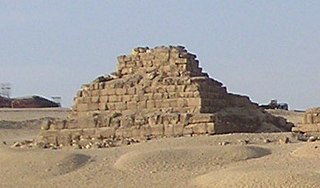
G3-c is one of the three pyramid companions Pyramid of Menkaure. It is located on the south side of the Menkaure pyramid in the Giza Necropolis. It is the westernmost of the three pyramids of the queens.

G3-a is one of the three pyramid companions of the Pyramid of Menkaure. It is located on the south side of the Menkaure pyramid in the Giza Necropolis. It is the easternmost of the three pyramids of the queens. The pyramid was built during the Fourth Dynasty of Egypt, presumably for one of the wives of Menkaure. The American archaeologist George Andrew Reisner was "confident" that the structure housed Khamerernebty II, but this is far from certain.

G3-b is one of the three pyramid companions Pyramid of Menkaure. It is located on the south side of the Menkaure pyramid in the Giza Necropolis. It is the middle of the three pyramids of the queens, and in the structure the body of a woman was discovered. The American archaeologist George Andrew Reisner speculated that the queen buried in the pyramid may have been Menkaure's half-sister, Shepsetkau, the daughter of Meresankh III and Khafre.
References
- ↑ Stadelmann, Rainer. "Builders of the Pyramids." Civilizations of the Ancient Near East 2 (1995): 719-734.